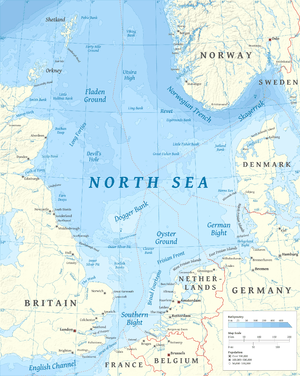Battle of Dogger Bank (1916)
| ||||||||||||||||||||||||||||||
The Battle of Dogger Bank on 10 February 1916 was a naval battle between the Kaiserliche Marine of the German Empire and the Royal Navy of the United Kingdom during the First World War. Three German torpedo boat flotillas sortied into the North Sea and encountered the British 10th Mine-sweeping Flotilla near Dogger Bank. The German vessels eventually engaged the British after mistaking the British vessels for cruisers instead of minesweeping sloops. Knowing they were out-gunned, the British attempted to flee. In the engagement that ensued, the sloop HMS Arabis was sunk before the British squadron was able to escape. Although the Germans were victorious, they inflated their victory by reporting they had sunk two British cruisers.
Background
With Admiral Hugo von Pohl becoming ill and Admiral Reinhard Scheer taking command of the German High Seas Fleet in 1916, the Germans began to take a more offensive strategy in the North Sea.[1] As part of this strategy, raids and incursions into British dominated areas became more frequent. The Germans sent the 2nd, 6th, and 9th Torpedo-Boat Flotillas on a sortie to Dogger Bank in an attempt to intercept Allied shipping.[2] Together, at least 25 torpedo boats were deployed.[3] The only British vessels in operating in the area were those of the British 10th Minesweeping Flotilla, consisting of HMS Arabis, Poppy, Buttercup, and Alyssum.[4] Each of these 1,250 long tons (1,270 t) Arabis-class sloops was armed only with two 4.7 in (120 mm) guns as well as two 3-pounder anti-aircraft guns and were little match to the large numbers of German torpedo boats pitted against them.[5]
Battle
Arabis—along with the other three sloops of her division—had been engaged in sweeping a clear channel east of Dogger Bank when they were sighted by a large number of German torpedo boats.[6] When the British sloops were first sighted, the Germans at first hesitated in attacking them as the new Arabis-class vessels could not be immediately identified. The Allied ships were mistaken for much more powerful cruisers, but the Germans decided to press their attack anyway as they had a significant numerical advantage. Upon being attacked, the British attempted to flee back to the safety of the coast. Although Poppy, Buttercup, and Alyssum were able to make good their escape, Arabis was not so fortunate and was caught and engaged by three of the German torpedo boats. After fighting off this attack, Arabis was again assailed. This time, six of the German boats attacked and Arabis finally went down after being struck by a torpedo.[7] Thirty of Arabis′ crew were pulled from the sea by the Germans, but four of them died shortly thereafter due to exposure to the elements.[8]
Aftermath
Besides some minor damage to a few of the German destroyers, the only losses from the action was HMS Arabis along with 56 of her crew killed and another 24 captured by the Germans, including Arabis' captain and two other officers. For his actions during the battle, Arabis′ commanding officer, Lieutenant Commander Robert Raymond Hallowell-Carew, received the Distinguished Service Order.[9] Despite the fact that they had only sunk a minesweeping sloop, the Germans claimed that they had engaged a squadron of four new cruisers and sunk two of them with torpedoes. The British Admiralty quickly responded by citing the truth, that no other Allied forces had been engaged besides the 10th Minesweeping Division and that no cruisers had been sunk in the action.[10]
In response to the action off Dogger Bank, the British deployed the Battlecruiser Fleet from Rosyth, the 5th Cruiser Division from Harwich, as well as other elements of the Grand Fleet. These British forces assembled in the North Sea and swept southward but abandoned their efforts on 11 February, when it became clear that the only German forces at sea had been torpedo boats and that these had already returned to base.[11] Returning from the sweep, the light cruiser HMS Arethusa struck a German mine and sank, losing 12 crew.[12]
Citations
References
- Books
- Gardiner, Robert (1985). Conway's All the World's Fighting Ships, 1906–1921. London: Conway Maritime Press. ISBN 0-85177-245-5.
- Halpern, Paul G. (1995). A Naval History of World War I. Annapolis, MD: US Naval Institute Press. ISBN 1-55750-352-4.
- Jellicoe, John Rushworth (1919). The Grand Fleet, 1914–1916: its Creation, Development and Work (PDF). New York: George H. Doran. OCLC 858560823. Retrieved 23 January 2016.
- The London Gazette: (Supplement) no. 31360. p. 6504. 23 May 1919. Retrieved 14 January 2010.
- Tarrant, V. E. (1995). Jutland, the German perspective: A New View of the Great Battle, 31 May 1916. Annapolis, MD: Naval Institute Press. ISBN 1-55750-408-3.
- Wilson, Herbert Wrigley (1926). Battleships in Action. 2. New York: Little, Brown. OCLC 3581564.
- Encyclopaedias
- Chisholm, Hugh (1922). The Encyclopædia Britannica. 31 (12th ed.). London: Encyclopædia Britannica. OCLC 154142008.
- Newspapers
- "SAYS ANOTHER SHIP SANK WITH THE ARABIS" (PDF). New York Times. February 13, 1916. p. 2. Retrieved 26 May 2016.
- Websites
- "British Convoy Escorts". World War 1 at Sea. Retrieved 16 January 2010.
Further reading
- Corbett, J. S. (2009) [1938]. Naval Operations (PDF). History of the Great War based on Official Documents. I (2nd rev. Imperial War Museum and Naval & Military Press repr. ed.). London: Longmans, Green. ISBN 1-84342-489-4. Retrieved 23 January 2016.
- Corbett, J. S. (2009) [1940]. Naval Operations. History of the Great War based on Official Documents. III (2nd ed.). London: Longmans, Green. OCLC 867968279. Retrieved 23 January 2016.
- Marder, A. J. (1965). From the Dreadnought to Scapa Flow: The War Years to the Eve of Jutland 1914–1916. II. London: Oxford University Press. OCLC 865180297.
- Massie, R. K. (2004) [2005]. Castles of Steel: Britain, Germany and the Winning of the Great War at Sea (Pimlico ed.). London: Jonathan Cape. ISBN 1-8441-3411-3.
